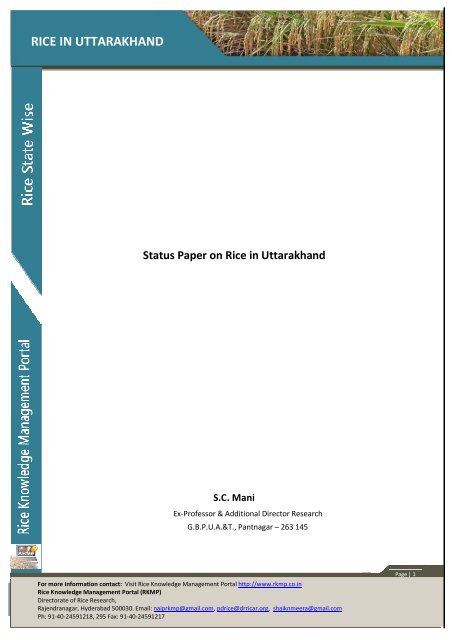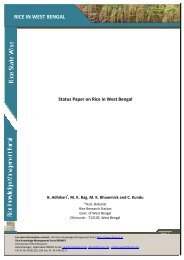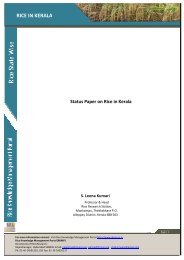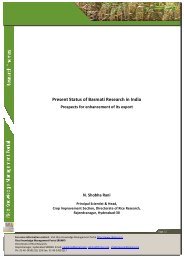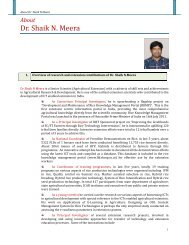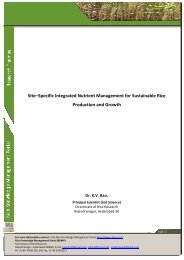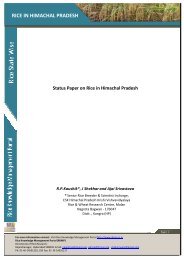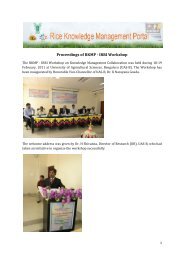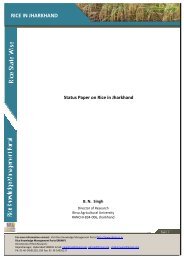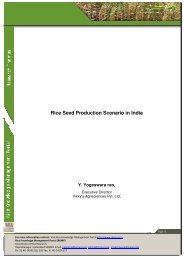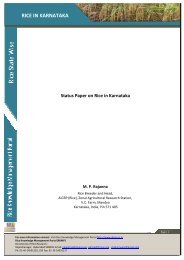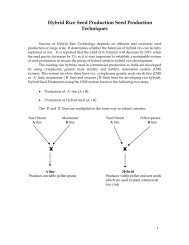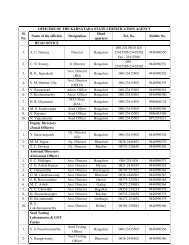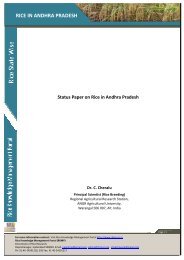Status Paper on Rice in Uttarakhand.pdf - Rice Knowledge ...
Status Paper on Rice in Uttarakhand.pdf - Rice Knowledge ...
Status Paper on Rice in Uttarakhand.pdf - Rice Knowledge ...
You also want an ePaper? Increase the reach of your titles
YUMPU automatically turns print PDFs into web optimized ePapers that Google loves.
RICE IN UTTARAKHAND<br />
<str<strong>on</strong>g>Status</str<strong>on</strong>g> <str<strong>on</strong>g>Paper</str<strong>on</strong>g> <strong>on</strong> <strong>Rice</strong> <strong>in</strong> <strong>Uttarakhand</strong><br />
S.C. Mani<br />
Ex-Professor & Additi<strong>on</strong>al Director Research<br />
G.B.P.U.A.&T., Pantnagar – 263 145<br />
For more Informati<strong>on</strong> c<strong>on</strong>tact: Visit <strong>Rice</strong> <strong>Knowledge</strong> Management Portal http://www.rkmp.co.<strong>in</strong><br />
<strong>Rice</strong> <strong>Knowledge</strong> Management Portal (RKMP)<br />
Directorate of <strong>Rice</strong> Research,<br />
Rajendranagar, Hyderabad 500030. Email: naiprkmp@gmail.com, pdrice@drricar.org, shaiknmeera@gmail.com<br />
Ph: 91-40-24591218, 295 Fax: 91-40-24591217<br />
Page | 1
RICE IN UTTARAKHAND<br />
I. NAME OF THE STATE : <strong>Uttarakhand</strong><br />
II.<br />
INTRODUCTION<br />
Created <strong>in</strong> the year 2000 this 27 th state of India, was carved out from erstwhile Uttar Pradesh.<br />
<strong>Uttarakhand</strong> is the 10 th Himalayan state of the country. It is bound by Nepal, Ch<strong>in</strong>a, Himachal Pradesh<br />
and Uttar Pradesh <strong>on</strong> east, northeast, west and southern directi<strong>on</strong>s, respectively. Out of the total<br />
geographical area of 53,204 sq. km. merely 14 per cent is under cultivati<strong>on</strong> and 62 per cent is under<br />
forest.<br />
<strong>Rice</strong> is the major cereal crop of kharif seas<strong>on</strong> account<strong>in</strong>g for more than 54 percent of the total area<br />
under cereals <strong>in</strong> the state. The annual rice producti<strong>on</strong> of the state is around 5.5 lakh t<strong>on</strong>nes from an area<br />
of about 2.80 lakh hectares. Half of this area is <strong>in</strong> the pla<strong>in</strong>s and half <strong>in</strong> the hills, but the total rice<br />
producti<strong>on</strong> of the hills is twice the total producti<strong>on</strong> of the hills. <strong>Rice</strong> is cultivated <strong>in</strong> all the 13 districts of<br />
the state, but maximum area (33%) is <strong>in</strong> district Udham S<strong>in</strong>gh Nagar which produces about 48% of the<br />
total rice produced annually <strong>in</strong> the state. Districts Na<strong>in</strong>ital, Hardwar and Dehradun occupy about 17.5 per<br />
cent area and c<strong>on</strong>tribute 22.2 per cent <strong>in</strong> the total producti<strong>on</strong>. From productivity po<strong>in</strong>t of view these<br />
districts are classified <strong>in</strong> the medium category. Rest of the n<strong>in</strong>e districts are classified <strong>in</strong> the low<br />
productivity category. These n<strong>in</strong>e districts together occupy about 49.2 per cent area, but c<strong>on</strong>tribute <strong>on</strong>ly<br />
to 30 per cent of the total producti<strong>on</strong>. After the creati<strong>on</strong> of the state some decl<strong>in</strong>e <strong>in</strong> rice area has been<br />
observed due to <strong>in</strong>dustrializati<strong>on</strong> <strong>in</strong> the pla<strong>in</strong>s and diversi<strong>on</strong> of area for other development purposes.<br />
III.<br />
ZONAL INFORMATION<br />
a. Climate :<br />
The climate varies greatly from place to place <strong>in</strong> this Himalayan state. The state<br />
comprises of two district physiographic regi<strong>on</strong>s: Hill regi<strong>on</strong> that covers major porti<strong>on</strong> and, the bhabhar<br />
and tarai regi<strong>on</strong>s that run as a narrow belt <strong>in</strong> the foothills of the Himalayas. The hilly terra<strong>in</strong> ranges from<br />
200 m to a magnificent series of snow clad peaks of more than 6000 m above mean sea level. Broadly<br />
there are three subdivisi<strong>on</strong>s viz., Himadari or greater Himalayas, Himanchal or lesser or lower Himalayas<br />
and Shivalik or sub-Himalayas. In Himadari, Himalaya rises abruptly and its higher peaks are ice-capped<br />
throughout the year. Crops are grown upto 2000 m <strong>in</strong> this part.<br />
In lower Himalaya (>600 to
RICE IN UTTARAKHAND<br />
climatic z<strong>on</strong>e <strong>in</strong> hill regi<strong>on</strong> are: warm temperate (900-1800 m), cool temperate (1800-2400 m), cold z<strong>on</strong>e<br />
(2400-3000 m), alp<strong>in</strong>e z<strong>on</strong>e (3000-4000 m), glacier z<strong>on</strong>e (4000-4800 m) and perpetually frozen z<strong>on</strong>e<br />
(>4800 m). The bhabhar and tarai regi<strong>on</strong>s represent a narrow strip of flat land below the foothills of<br />
Himalayas cover<strong>in</strong>g about <strong>on</strong>e third of total arable land <strong>in</strong> the state. Bhabhar occupies the area just<br />
below the foothills. Mov<strong>in</strong>g further down, bhabhar leads to tarai z<strong>on</strong>e that covers districts of Udham<br />
S<strong>in</strong>gh Nagar, Haridwar and parts of Na<strong>in</strong>ital district. In this regi<strong>on</strong> <strong>in</strong>tensive agriculture is practiced.<br />
b. Soil Type/ Nutrient Management<br />
The soils <strong>in</strong> the hills have developed from rocks like granite, ferrug<strong>in</strong>ous biotitic, schists,<br />
gneiss, phyllite, shales and sand st<strong>on</strong>e, etc. under cool and moist climate. Soils of the hill regi<strong>on</strong> are<br />
characterized by their diversity due to parent rock, elevati<strong>on</strong>, slope and aspect. They are generally<br />
shallow, gravelly, impregnated with un-weathered fragments of parent rocks, occurr<strong>in</strong>g as a th<strong>in</strong> layer<br />
of a few centimeters at high elevati<strong>on</strong>s to about 2 meters <strong>in</strong> the valleys or depressi<strong>on</strong>s. They are neutral<br />
to slightly acidic <strong>in</strong> nature at lower elevati<strong>on</strong>s and highly acidic at higher elevati<strong>on</strong>s where ra<strong>in</strong>fall is<br />
high. The hill soils bel<strong>on</strong>g mostly to <strong>in</strong>ceptisol and alfisol orders and are pr<strong>on</strong>e to severe water erosi<strong>on</strong><br />
due to steep slope and high ra<strong>in</strong>fall.<br />
The soils of bhabhar are deep, well dra<strong>in</strong>ed, neutral or slightly alkal<strong>in</strong>e, coarse loamy/ f<strong>in</strong>e loamy/<br />
sandy and with or without free lime (calcareous/ n<strong>on</strong>-calcareous). At places, deep, excessively dra<strong>in</strong>ed<br />
soils occur. The major c<strong>on</strong>stra<strong>in</strong>ts of soils of piedment pla<strong>in</strong> are the low moisture hold<strong>in</strong>g capacity and<br />
limited root growth z<strong>on</strong>e. The soils of tarai are very deep, well dra<strong>in</strong>ed, slightly alkal<strong>in</strong>e and coarse<br />
loamy/ f<strong>in</strong>e loamy. These soils are rich <strong>in</strong> organic matter, plant nutrients and have fairly good water<br />
hold<strong>in</strong>g capacity. At places the problems of wetness, overflows and erosi<strong>on</strong> are also observed. Tarai<br />
soils are <strong>on</strong>e of the most productive soils <strong>in</strong> the country.<br />
c. Ra<strong>in</strong>fall and its Distributi<strong>on</strong> Pattern<br />
Ra<strong>in</strong>fall is heavy <strong>in</strong> Himalayas as well as <strong>in</strong> foot hills. The area of heaviest ra<strong>in</strong>fall are <strong>in</strong> the districts<br />
of Dehradun, Garhwal, Na<strong>in</strong>ital and Pithoragarh with an average ra<strong>in</strong>fall of 1800 mm. The other hills <strong>in</strong><br />
general receive 750-1250 mm annually. Of the total ra<strong>in</strong>fall, 80-90% is c<strong>on</strong>centrated <strong>in</strong> m<strong>on</strong>so<strong>on</strong> period<br />
viz., June-August.<br />
d. Agro-Climatic Z<strong>on</strong>es<br />
Broadly, the state can be divided <strong>in</strong>to four dist<strong>in</strong>ct agro-climatic regi<strong>on</strong>:<br />
For more Informati<strong>on</strong> c<strong>on</strong>tact: Visit <strong>Rice</strong> <strong>Knowledge</strong> Management Portal http://www.rkmp.co.<strong>in</strong><br />
<strong>Rice</strong> <strong>Knowledge</strong> Management Portal (RKMP)<br />
Directorate of <strong>Rice</strong> Research,<br />
Rajendranagar, Hyderabad 500030. Email: naiprkmp@gmail.com, pdrice@drricar.org, shaiknmeera@gmail.com<br />
Ph: 91-40-24591218, 295 Fax: 91-40-24591217<br />
Page | 3
RICE IN UTTARAKHAND<br />
• Valleys (up to 1000 m above sea level) it comprises the districts of Udham S<strong>in</strong>gh Nagar, Hardwar<br />
and parts of Dehradun.<br />
• Low hills (1000-1500 m above sea level) marked by unirrigated stretches of sub-tropical land,<br />
<strong>in</strong>clud<strong>in</strong>g districts and areas of Pauri, Tehri, Dehradun and Na<strong>in</strong>ital districts.<br />
• High hills (1500-2500 m) marked by cool, temperate climate <strong>in</strong>cludes area <strong>in</strong> Uttarkashi, Na<strong>in</strong>ital,<br />
Rudraprayag, Pauri, Bageshwar, Champawat and Chamoli districts.<br />
• Alp<strong>in</strong>e z<strong>on</strong>e (>2500m), the regi<strong>on</strong> is marked by sparse vegetati<strong>on</strong>, ma<strong>in</strong>ly herbs and small<br />
mounta<strong>in</strong>eous plants and <strong>in</strong>cludes areas <strong>in</strong> Uttarkashi, Chamoli and Pithoragarh districts.<br />
Physiographic z<strong>on</strong>es, farm<strong>in</strong>g situati<strong>on</strong>s, soil and major crops grown <strong>in</strong> <strong>Uttarakhand</strong><br />
Sl.<br />
No.<br />
Z<strong>on</strong>e Farm<strong>in</strong>g situati<strong>on</strong>s Soil Av. Ra<strong>in</strong>fall<br />
(mm/year)<br />
1.<br />
2.<br />
3.<br />
4.<br />
Z<strong>on</strong>e-A<br />
(up to 1000m)<br />
Z<strong>on</strong>e-B<br />
(1000-1500m)<br />
Z<strong>on</strong>e-C<br />
(1500-2400)<br />
Z<strong>on</strong>e-D<br />
(>2400)<br />
Tarai irrigated Alluvial 1400<br />
Bhabar irrigated Alluvial 1400<br />
Lower hills irrigated Alluvial sandy 2000-2400<br />
Ra<strong>in</strong>fed lower hiills Residual sandy loam 2000-2400<br />
Mid hills south aspect Sandy loam 1200-1300<br />
High hills Red to dark 1200-2500<br />
Very high hiils Red to dark black clay 1300<br />
e. <strong>Rice</strong> and Cultural Heritage <strong>in</strong> the State<br />
<strong>Rice</strong> apart from be<strong>in</strong>g a source of food is <strong>in</strong>timately related with all the religious, cultural and<br />
social functi<strong>on</strong>s of the life of hill people. It also provides feed for cattle, thereby, reduc<strong>in</strong>g pressure <strong>on</strong><br />
graz<strong>in</strong>g land and forests. Thus, rice helps to balance the delicate ecosystem of Himalayas, where<br />
For more Informati<strong>on</strong> c<strong>on</strong>tact: Visit <strong>Rice</strong> <strong>Knowledge</strong> Management Portal http://www.rkmp.co.<strong>in</strong><br />
<strong>Rice</strong> <strong>Knowledge</strong> Management Portal (RKMP)<br />
Directorate of <strong>Rice</strong> Research,<br />
Rajendranagar, Hyderabad 500030. Email: naiprkmp@gmail.com, pdrice@drricar.org, shaiknmeera@gmail.com<br />
Ph: 91-40-24591218, 295 Fax: 91-40-24591217<br />
Page | 4
RICE IN UTTARAKHAND<br />
fodder scarcity is more acute. <strong>Rice</strong> is cultivated <strong>in</strong> hills of state <strong>in</strong> two dist<strong>in</strong>ct envir<strong>on</strong>ments; terraces<br />
and valleys. The promis<strong>in</strong>g rice establishment method <strong>in</strong> terraces is direct-seeded (dry seed and dry<br />
soil), while valleys are transplanted (establishment of seedl<strong>in</strong>gs <strong>in</strong> nursery and subsequently<br />
transplanted <strong>in</strong> well puddled fields). These variati<strong>on</strong>s are largely expla<strong>in</strong>ed by poor <strong>in</strong>frastructure,<br />
<strong>in</strong>accessibility to modern technology, small and fragmented land hold<strong>in</strong>gs, use of traditi<strong>on</strong>al <strong>in</strong>puts<br />
and methods: n<strong>on</strong>-availability and n<strong>on</strong>-suitability of seeds and fertilizers which affect hill agriculture<br />
significantly. Applicati<strong>on</strong> of chemical fertilizers <strong>in</strong> hills is <strong>on</strong>ly 8 kg per hectare, whereas the state<br />
average is about 75 kg per hectare.<br />
IV. RICE PRODUCTION SCENARIO<br />
The current rice grow<strong>in</strong>g area (2009-10) <strong>in</strong> the state is about 2.8 lakh hectares and producti<strong>on</strong> is<br />
5.7 lakh qu<strong>in</strong>tals. Half of this area is <strong>in</strong> the hills and half <strong>in</strong> the pla<strong>in</strong>s, but the total producti<strong>on</strong> <strong>in</strong> the<br />
pla<strong>in</strong>s is almost two and half times the producti<strong>on</strong> <strong>in</strong> the hills. The average productivity of the state is<br />
20.39 q/ha. There is a wide gap between the productivity of hills (12.55 q/ha) and productivity of<br />
pla<strong>in</strong>s (27.55 q/ha). The highest productivity am<strong>on</strong>g hill districts was observed <strong>in</strong> Tehri Garhwal which<br />
is 1.6 t/ha and lowest <strong>in</strong> Almora and Pauri Garhwal districts which is about 1 t/ha. The ma<strong>in</strong> reas<strong>on</strong>s<br />
for a wide difference <strong>in</strong> productivity are (i) There exists a wide variati<strong>on</strong> between hills and pla<strong>in</strong>s for<br />
irrigati<strong>on</strong> facilities and fertilizer c<strong>on</strong>sumpti<strong>on</strong> (ii) The hill districts witness harsh climate <strong>in</strong> terms of<br />
prevail<strong>in</strong>g low temperature and moisture stress (iii) Very low or negligible use of chemical fertilizers <strong>in</strong><br />
the hills, particularly under ra<strong>in</strong>fed upland c<strong>on</strong>diti<strong>on</strong>s (iv) Small or marg<strong>in</strong>al and scattered land<br />
hold<strong>in</strong>gs and woman based agriculture (v) N<strong>on</strong>-availability of <strong>in</strong>puts, poor socio-ec<strong>on</strong>omic c<strong>on</strong>diti<strong>on</strong> of<br />
the farmers and poor extensi<strong>on</strong> network.<br />
The major factors c<strong>on</strong>tribut<strong>in</strong>g to high yields <strong>in</strong> the pla<strong>in</strong>s are high yield<strong>in</strong>g varieties, irrigati<strong>on</strong><br />
facilities and adopti<strong>on</strong> of modern crop producti<strong>on</strong> and crop protecti<strong>on</strong> technologies. In the valleys where<br />
rice yields are as high as <strong>in</strong> the pla<strong>in</strong>s the irrigati<strong>on</strong> water plays the most crucial role.<br />
V. REGION-WISE/ DISTRICT-WISE RICE ECOSYSTEMS<br />
There are two dist<strong>in</strong>ct rice ecosystems <strong>in</strong> the state. District Udham S<strong>in</strong>gh Nagar, Hardwar and<br />
pla<strong>in</strong>s of Na<strong>in</strong>ital and Dehradun districts grow rice under irrigated ecosystem. Rest of the n<strong>in</strong>e districts<br />
viz., Almora, Bageshwar, Champawat, Pithoragarh, Chamoli, Uttarkashi, Rudraprayag, Pauri, Tehri and hill<br />
regi<strong>on</strong>s of districts Dehradun and Na<strong>in</strong>ital are under ra<strong>in</strong>fed upland ecosystem.<br />
For more Informati<strong>on</strong> c<strong>on</strong>tact: Visit <strong>Rice</strong> <strong>Knowledge</strong> Management Portal http://www.rkmp.co.<strong>in</strong><br />
<strong>Rice</strong> <strong>Knowledge</strong> Management Portal (RKMP)<br />
Directorate of <strong>Rice</strong> Research,<br />
Rajendranagar, Hyderabad 500030. Email: naiprkmp@gmail.com, pdrice@drricar.org, shaiknmeera@gmail.com<br />
Ph: 91-40-24591218, 295 Fax: 91-40-24591217<br />
Page | 5
RICE IN UTTARAKHAND<br />
VI. RICE PRODUCTION AND ECONOMIC ANALYSIS<br />
The average costs and returns from rice cultivati<strong>on</strong> <strong>in</strong> district Udham S<strong>in</strong>gh Nagar is given <strong>in</strong> Table<br />
given at XVII. The total cost of rice producti<strong>on</strong> <strong>in</strong> tarai is high due to very high cost of the labour, full<br />
applicati<strong>on</strong> of fertilizers and plant protecti<strong>on</strong> chemicals. Due to higher yields rice cultivati<strong>on</strong> is a<br />
profitable propositi<strong>on</strong> and average returns are around Rs. 20,000 per hectare. Farmers <strong>in</strong>volved <strong>in</strong> seed<br />
producti<strong>on</strong> and cultivati<strong>on</strong> of basmati rice make even higher profits.<br />
The cost of cultivati<strong>on</strong> of rice is Rs. 13609/ha <strong>in</strong> the valleys which is about 44% more than that <strong>on</strong><br />
the terrace (Rs. 8710). The material cost, which <strong>in</strong>cludes bullock power, FYM, seed, irrigati<strong>on</strong> and<br />
fertilizer worked out to be Rs. 4611/ha account<strong>in</strong>g for 53% to the total cost <strong>on</strong> terraces and Rs. 6552 <strong>in</strong><br />
valleys, account<strong>in</strong>g for 48% to total cost. Material cost is more <strong>in</strong> valleys due to use of chemical fertilizers.<br />
FYM is the most important <strong>in</strong>put followed by seed, which together account for 37 % to total cost<br />
<strong>in</strong> terraces, while <strong>in</strong> valleys bullock power is the most important comp<strong>on</strong>ent of material cost with 17 % to<br />
the total cost followed by FYM hav<strong>in</strong>g 12% share. In both the situati<strong>on</strong>s human labour <strong>in</strong>clude <strong>on</strong>ly family<br />
labour. Labour cost is Rs. 4099 <strong>in</strong> terraces and Rs. 7057/ha <strong>in</strong> valleys which c<strong>on</strong>stitute 47 and 52 %,<br />
respectively to total cost. Weed<strong>in</strong>g cost emerged out as a ma<strong>in</strong> comp<strong>on</strong>ent of labour cost <strong>in</strong> terraces. It is Rs.<br />
1602 for terraces and Rs. 1043/ha for valleys, followed by harvest<strong>in</strong>g cost of Rs. 919 and Rs. 1730 <strong>in</strong> terraces<br />
and valleys, respectively. The yields of rice are 31.2 and 9.37 qtls/ha <strong>in</strong> valleys and terraces, respectively. The<br />
yield differences were due to n<strong>on</strong>-adopti<strong>on</strong> of modern technologies <strong>in</strong> terraces due to irrigati<strong>on</strong> problems.<br />
Large differences are observed <strong>in</strong> gross returns from rice cultivati<strong>on</strong> <strong>in</strong> two heterogeneous rice<br />
grow<strong>in</strong>g envir<strong>on</strong>ments. In valleys gross returns are about three times (Rs. 17864/ha) than that of terraces<br />
(Rs. 6149). Adopti<strong>on</strong>s of modern technologies for rice cultivati<strong>on</strong> <strong>in</strong> valleys are al<strong>on</strong>e sufficient to expla<strong>in</strong><br />
the variati<strong>on</strong> <strong>in</strong> gross and net returns. The net returns are negative<br />
(- Rs. 2561/ha) <strong>in</strong> terraces<br />
and positive <strong>in</strong> valleys (+ Rs. 4255/ha).<br />
VII. RICE AND RICE BASED CROPPING SYSTEM ZONE-WISE<br />
Situati<strong>on</strong>(s) Crop Sequences Altitude<br />
Z<strong>on</strong>e-A <strong>Rice</strong>-wheat upto 1000 m<br />
<strong>Rice</strong>-vegetable pea-summer rice<br />
Basmati rice – lentil/ local scented rice - lentil<br />
For more Informati<strong>on</strong> c<strong>on</strong>tact: Visit <strong>Rice</strong> <strong>Knowledge</strong> Management Portal http://www.rkmp.co.<strong>in</strong><br />
<strong>Rice</strong> <strong>Knowledge</strong> Management Portal (RKMP)<br />
Directorate of <strong>Rice</strong> Research,<br />
Rajendranagar, Hyderabad 500030. Email: naiprkmp@gmail.com, pdrice@drricar.org, shaiknmeera@gmail.com<br />
Ph: 91-40-24591218, 295 Fax: 91-40-24591217<br />
Page | 6
RICE IN UTTARAKHAND<br />
Z<strong>on</strong>e-B<br />
(1000-1500m)<br />
<strong>Rice</strong>-wheat-mandua-fallow (two year) 1000-1500m<br />
Local scented rice) - wheat<br />
Local scented rice) - lentil<br />
<strong>Rice</strong>- mustard<br />
<strong>Rice</strong>-wheat<br />
Z<strong>on</strong>e-C Amaranth (Ramdana) – wheat / barley 1500-2400 m<br />
Rajma - wheat / barley<br />
Buckwheat – barely<br />
Z<strong>on</strong>e-D Buckwheat – barely above 2400m<br />
Amaranth – barley<br />
VIII. RICE GROWING SEASONS OF DIFFERENT REGIONS<br />
<strong>Rice</strong> is predom<strong>in</strong>antly cultivated dur<strong>in</strong>g the kharif seas<strong>on</strong> <strong>in</strong> the state. In hill valleys high yield<strong>in</strong>g<br />
rice varieties are popular, whereas traditi<strong>on</strong>al varieties are grown <strong>on</strong> the terraces which show c<strong>on</strong>trast<strong>in</strong>g<br />
climatic c<strong>on</strong>diti<strong>on</strong>s to valley situati<strong>on</strong>s. In terraces farm<strong>in</strong>g activities beg<strong>in</strong> immediately after ra<strong>in</strong>s as they<br />
are ma<strong>in</strong>ly ra<strong>in</strong>fed. Valleys are irrigated by the hill canals. In both envir<strong>on</strong>ments land preparati<strong>on</strong> is totally<br />
dependent <strong>on</strong> bullock power. Mechanizati<strong>on</strong> is not popular due to bio-physical c<strong>on</strong>diti<strong>on</strong>s and small size<br />
of plots and sloppy situati<strong>on</strong>s. However, rice establishment methods differ <strong>in</strong> both envir<strong>on</strong>ments.<br />
Terraces are entirely direct seeded (dry-seed and dry- soil), while <strong>in</strong> valleys transplant<strong>in</strong>g is the most<br />
popular rice establishment method.<br />
Dur<strong>in</strong>g the last <strong>on</strong>e and half decades summer rice has also became popular <strong>in</strong> the tarai regi<strong>on</strong> of<br />
district Udham S<strong>in</strong>gh Nagar from February/<br />
March – May/ June. Short durati<strong>on</strong> varieties<br />
transplanted after vegetable pea. Availability of irrigati<strong>on</strong> water <strong>in</strong> tarai is the ma<strong>in</strong> reas<strong>on</strong> for the success<br />
of summer rice.<br />
For more Informati<strong>on</strong> c<strong>on</strong>tact: Visit <strong>Rice</strong> <strong>Knowledge</strong> Management Portal http://www.rkmp.co.<strong>in</strong><br />
<strong>Rice</strong> <strong>Knowledge</strong> Management Portal (RKMP)<br />
Directorate of <strong>Rice</strong> Research,<br />
Rajendranagar, Hyderabad 500030. Email: naiprkmp@gmail.com, pdrice@drricar.org, shaiknmeera@gmail.com<br />
Ph: 91-40-24591218, 295 Fax: 91-40-24591217<br />
Page | 7
RICE IN UTTARAKHAND<br />
IX. RECOMMENDED PACKAGE OF PRACTICES<br />
a. Varieties/Hybrids<br />
i. Irrigated pla<strong>in</strong>s:<br />
a) Early (110-115 days): Gov<strong>in</strong>d, Narendra Dhan-118, Saket-4, Narendra Dhan-97, Pant<br />
Sankar Dhan-1.<br />
b) Medium (120-125 days): Pant Dhan-4, Narendra Dhan-359, Pant Dhan-10, Saryu-52,<br />
PNR-381, Pant Sankar Dhan-3,<br />
113, PR-114.<br />
Narendra Sankar Dhan-2, Pant Dhan-18, Pant Dhan-19, PR-<br />
c) Basmati varieties: Type-3, Kasturi, Pusa Basmati-1, Basmati-370, Taraori Basmat, Haryana<br />
Basmati-1, Pant Sugandh Dhan-15,<br />
Pant Sugandh Dhan-17, Pusa-1121, Pusa RH-10.<br />
ii. Hills:<br />
1. Direct seeded upland<br />
a. Spr<strong>in</strong>g (March/ April seeded) : Locally this is known as chetaki dhan. The varieties are<br />
Majhera-3, Pant Majhera Dhan-7, VL Dhan-206, VL Dhan-207, VL Dhan-208 and VL Dhan-209.<br />
b. June seeded: Locally known as jethi dhan. The varieties are VL Dhan-163, VL Dhan-<br />
221, Vivek Dhan-154.<br />
2. Irrigated<br />
a. Lower hills: Saket-4, Prasad, Gov<strong>in</strong>d, Pant Dhan-11.<br />
b. Medium hills<br />
(i) Early matur<strong>in</strong>g: VLK Dhan-39, Pant Dhan-6, VL Dhan-81, VL Dhan-85, Vivek<br />
Dhan-82.<br />
(ii)<br />
Medium matur<strong>in</strong>g: VL Dhan-16, VL Dhan-61, VL Dhan-65, Vivek Dhan-62.<br />
b. Management Inclusive of Mechanizati<strong>on</strong><br />
Time of Nursery Sow<strong>in</strong>g and Transplant<strong>in</strong>g<br />
Sl.<br />
No.<br />
Field situati<strong>on</strong> Time of nursery sow<strong>in</strong>g Time of transplant<strong>in</strong>g<br />
For more Informati<strong>on</strong> c<strong>on</strong>tact: Visit <strong>Rice</strong> <strong>Knowledge</strong> Management Portal http://www.rkmp.co.<strong>in</strong><br />
<strong>Rice</strong> <strong>Knowledge</strong> Management Portal (RKMP)<br />
Directorate of <strong>Rice</strong> Research,<br />
Rajendranagar, Hyderabad 500030. Email: naiprkmp@gmail.com, pdrice@drricar.org, shaiknmeera@gmail.com<br />
Ph: 91-40-24591218, 295 Fax: 91-40-24591217<br />
Page | 8
RICE IN UTTARAKHAND<br />
1. Valleys and lower hills up<br />
to 900 m<br />
Sec<strong>on</strong>d fortnight of May to first<br />
week of June<br />
June end to first week<br />
of July<br />
2. Mid hills (900-1500 m) First fortnight of May Sec<strong>on</strong>d fortnight of June<br />
3. High hills (above 1500 m) Sec<strong>on</strong>d fortnight of April First fortnight of June<br />
4. Tarai and bhabhar<br />
HYV’s<br />
Sec<strong>on</strong>d fortnight of May to first<br />
fortnight of June depend<strong>in</strong>g up<strong>on</strong><br />
the durati<strong>on</strong> of the variety<br />
Sec<strong>on</strong>d fortnight of June to<br />
first fortnight of July<br />
5. Basmati varieties 15-20 June Mid July<br />
Recommended Fertilizers and Doses<br />
Sl. No. Cropp<strong>in</strong>g situati<strong>on</strong> Varietal group Area (unit) N P K<br />
Hills<br />
1. Ra<strong>in</strong>fed upland Local and tall Hectare 40-50 kg 30 kg 20 kg<br />
Nali 800-1000 g 600 g 400 g<br />
2. Irrigated Semi-dwarf Hectare 120 kg 60 kg 40 kg<br />
Nali 1.2 kg 0.6 kg 0.6 kg<br />
Pla<strong>in</strong>s HYV’s Hectare 120 kg 60 kg 40 kg<br />
Hybrids Hectare 150 kg 60 kg 60 kg<br />
Basmati Hectare 100 kg 60 kg 40 kg<br />
Tall/<br />
Basmati<br />
Local<br />
Hectare 60 kg 30 kg 30 kg<br />
Recommended Weedicides<br />
Sl.<br />
No.<br />
Name of weedicide<br />
Quantity<br />
Per hectare<br />
Per nali<br />
1. Butachlor 50 EC 3.0 l 60 ml<br />
For more Informati<strong>on</strong> c<strong>on</strong>tact: Visit <strong>Rice</strong> <strong>Knowledge</strong> Management Portal http://www.rkmp.co.<strong>in</strong><br />
<strong>Rice</strong> <strong>Knowledge</strong> Management Portal (RKMP)<br />
Directorate of <strong>Rice</strong> Research,<br />
Rajendranagar, Hyderabad 500030. Email: naiprkmp@gmail.com, pdrice@drricar.org, shaiknmeera@gmail.com<br />
Ph: 91-40-24591218, 295 Fax: 91-40-24591217<br />
Page | 9
RICE IN UTTARAKHAND<br />
2. Thiobencarb 50 EC 3.0 l 60 ml<br />
3. Anilophos 30 EC 1.65 l 33 ml<br />
4. Protilachlor 50 EC 1.5 l 30 ml<br />
5. Pandimithil<strong>in</strong> 30 EC (for direct seeded crop) 3.3 l 66 ml<br />
Important Diseases and their C<strong>on</strong>trol<br />
Sl.<br />
No.<br />
Disease Fungicide Rate of applicati<strong>on</strong><br />
Per ha<br />
Per nali<br />
1. Blast Tricyclazole 75 w.p. 600 g 12 g<br />
2. Brown spot Mancozeb 0.25% soluti<strong>on</strong><br />
3. Sheath rot Carbendazim 1 kg 20 g<br />
4. Sheath blight Propac<strong>on</strong>azole or<br />
Hexac<strong>on</strong>azole<br />
1.0 l<br />
2.0 l<br />
20 ml<br />
40 ml<br />
5. Bacterial blight Streptocyclim +<br />
Copper oxychloride<br />
15.0 g<br />
500.0 g<br />
-<br />
-<br />
Important Insects and their C<strong>on</strong>trol<br />
Sl.<br />
No.<br />
Insect pest Insecticide Rate of applicati<strong>on</strong><br />
Per ha<br />
per nail<br />
1. Hopper Imidachloprid 400 ml 8 ml<br />
2. Stem borer Cartap hydrochloride 4G or 25 kg 500 g<br />
Fipr<strong>on</strong>il 5 EC or 1.0 l 20 ml<br />
For more Informati<strong>on</strong> c<strong>on</strong>tact: Visit <strong>Rice</strong> <strong>Knowledge</strong> Management Portal http://www.rkmp.co.<strong>in</strong><br />
<strong>Rice</strong> <strong>Knowledge</strong> Management Portal (RKMP)<br />
Directorate of <strong>Rice</strong> Research,<br />
Rajendranagar, Hyderabad 500030. Email: naiprkmp@gmail.com, pdrice@drricar.org, shaiknmeera@gmail.com<br />
Ph: 91-40-24591218, 295 Fax: 91-40-24591217<br />
Page | 10
RICE IN UTTARAKHAND<br />
Cartap hydrochloride 50 w.p. 600 g 12 g<br />
3. Hispa Chlorpyriphos 1.5 l 15 ml<br />
4. Leaf folder Cartap hydrochloride 50 w.p. 600 g 12 g<br />
5. Kurmula Neem cake + 7.8 q 14.16 kg<br />
Qu<strong>in</strong>olphos 25 EC<br />
4.0 l 80 ml<br />
or<br />
Chlorpyriphos 20 EC 4.0 l 80 ml<br />
X. INDIGENOUS TECHNICAL KNOWLEDGE (ITKS) SPECIFIC TO THE STATE<br />
(i) Direct seed<strong>in</strong>g of rice <strong>on</strong> terraces and hill slopes <strong>in</strong> the m<strong>on</strong>th of March/ April mak<strong>in</strong>g use of the<br />
moisture c<strong>on</strong>served from w<strong>in</strong>ter ra<strong>in</strong>s and precipitati<strong>on</strong>.<br />
(ii) Technique of nursery rais<strong>in</strong>g dur<strong>in</strong>g the m<strong>on</strong>ths of December/ January for summer rice when<br />
envir<strong>on</strong>mental/ soil/ water temperature is very low and unsuitable for germ<strong>in</strong>ati<strong>on</strong> of rice by<br />
bengali farmers <strong>in</strong> <strong>Uttarakhand</strong> tarai us<strong>in</strong>g c<strong>on</strong>t<strong>in</strong>uously runn<strong>in</strong>g water of artigen wells.<br />
XI. BYPRODUCTS/EXTENDED USE OF RICE SPECIFIC TO THE STATE<br />
Paddy is turned <strong>in</strong>to white milled/ parboiled rice and c<strong>on</strong>sumed as whole gra<strong>in</strong> al<strong>on</strong>g with curry<br />
and vegetables. There are no specific milled products. Other food products <strong>in</strong>clude beaten rice, puffed<br />
rice, kheer, namk<strong>in</strong>, papad, kachari, arsa and some products of regi<strong>on</strong>al importance. <strong>Rice</strong> straw is burned<br />
by the farmers <strong>in</strong> tarai after comb<strong>in</strong>e harvest<strong>in</strong>g, but is used as cattle feed by the farmers <strong>in</strong> the hills. <strong>Rice</strong><br />
millers use the husk <strong>in</strong> the boilers of their own rice mills for parboil<strong>in</strong>g as well as sell to other small<br />
<strong>in</strong>dustries to be used as fuel <strong>in</strong> the boilers.<br />
XII. RICE AND COMMERCE (EXPORT AND REVENUE GENERATION)<br />
<strong>Uttarakhand</strong> state is orig<strong>in</strong>ally hill state. Under the organic basmati export programme of UOCB<br />
the area of basmati rice has <strong>in</strong>creased from 700 ha <strong>in</strong> 2006-07 to 1829 ha <strong>in</strong> 2007-08 with an<br />
average productivity of<br />
20.0 q/ha for different varieties (UOCB, 2008). Exact data about rice<br />
exports are not available. It is estimated that around 1,000-1,500 t<strong>on</strong>nes of basmati rice is exported from<br />
For more Informati<strong>on</strong> c<strong>on</strong>tact: Visit <strong>Rice</strong> <strong>Knowledge</strong> Management Portal http://www.rkmp.co.<strong>in</strong><br />
<strong>Rice</strong> <strong>Knowledge</strong> Management Portal (RKMP)<br />
Directorate of <strong>Rice</strong> Research,<br />
Rajendranagar, Hyderabad 500030. Email: naiprkmp@gmail.com, pdrice@drricar.org, shaiknmeera@gmail.com<br />
Ph: 91-40-24591218, 295 Fax: 91-40-24591217<br />
Page | 11
RICE IN UTTARAKHAND<br />
the state every year, mostly to middle east. Some basmati rice also moves <strong>in</strong> adjo<strong>in</strong><strong>in</strong>g states and Delhi<br />
markets.<br />
XIII. SPECIAL DEVELOPMENT PROGRAMME IN RICE SECTOR OF THE STATE<br />
Sl.<br />
No.<br />
Comp<strong>on</strong>ents<br />
Maximum permissible assistance<br />
1. Dem<strong>on</strong>strati<strong>on</strong> of improved package of<br />
practices<br />
2. Dem<strong>on</strong>strati<strong>on</strong> <strong>on</strong> System of <strong>Rice</strong><br />
Intensificati<strong>on</strong><br />
Rs. 2,500 per dem<strong>on</strong>strati<strong>on</strong> of 0.4 ha<br />
(Assistance limited to Rs. 2,500/- per acre for<br />
s<strong>in</strong>gle crop)<br />
Rs. 3,000 per dem<strong>on</strong>strati<strong>on</strong> of 0.4 ha<br />
3. Dem<strong>on</strong>strati<strong>on</strong> <strong>on</strong> hybrid rice technology Rs. 3,000 per dem<strong>on</strong>strati<strong>on</strong> of 0.4 ha<br />
4. Support for promoti<strong>on</strong> of hybrid rice seed<br />
a) Assistance for producti<strong>on</strong> of hybrid<br />
seed.<br />
b) Assistance for distributi<strong>on</strong> of<br />
hybrid rice seed<br />
Rs. 1,000 per qtl or 50% of the cost,<br />
whichever is less<br />
Rs. 2,000 per qtl or 50% of the cost,<br />
whichever is less<br />
5. Assistance for distributi<strong>on</strong> of HYVs Seed Assistance @ Rs. 5 per kg or 50% of the cost,<br />
whichever is less<br />
6. Seed M<strong>in</strong>i kits of high yield<strong>in</strong>g varieties Full cost of the seed<br />
7. Incentive for micro nutrients (<strong>in</strong> deficient<br />
soils)<br />
Assistance @ Rs. 500 per ha or 50% of the<br />
cost, whichever is less<br />
8. Incentive for lim<strong>in</strong>g <strong>in</strong> acid soils Assistance @ 500 per ha or 50% of the cost,<br />
whichever is less<br />
9. Assistance for plant protecti<strong>on</strong> chemicals<br />
and bio-pesticides<br />
Assistance @ Rs. 500 per ha or 50% of the<br />
cost, whichever is less<br />
10. Tra<strong>in</strong><strong>in</strong>g of farmers at FFS pattern Assistance @ Rs. 17,000 per tra<strong>in</strong><strong>in</strong>g<br />
11. Fr<strong>on</strong>tl<strong>in</strong>e Dem<strong>on</strong>strati<strong>on</strong> <strong>on</strong> rice Rs. 6,250 per ha.<br />
12. Fr<strong>on</strong>tl<strong>in</strong>e Dem<strong>on</strong>strati<strong>on</strong> <strong>on</strong> hybrid rice Rs. 7,500 per ha.<br />
For more Informati<strong>on</strong> c<strong>on</strong>tact: Visit <strong>Rice</strong> <strong>Knowledge</strong> Management Portal http://www.rkmp.co.<strong>in</strong><br />
<strong>Rice</strong> <strong>Knowledge</strong> Management Portal (RKMP)<br />
Directorate of <strong>Rice</strong> Research,<br />
Rajendranagar, Hyderabad 500030. Email: naiprkmp@gmail.com, pdrice@drricar.org, shaiknmeera@gmail.com<br />
Ph: 91-40-24591218, 295 Fax: 91-40-24591217<br />
Page | 12
RICE IN UTTARAKHAND<br />
Sl.<br />
No.<br />
Comp<strong>on</strong>ents<br />
Maximum permissible assistance<br />
13. Purchase of manually operated<br />
implements/ tools<br />
@ 25% of the cost limited to Rs. 2,000/-<br />
14. Animal driven implements @ 25% of the cost limited to Rs. 2,500/-<br />
15. Power driven equipments (Tractor/ power<br />
tiller operated)<br />
Intended <strong>in</strong>clusi<strong>on</strong> of all tractor and power<br />
tiller driven c<strong>on</strong>venti<strong>on</strong>al equipment/<br />
implements<br />
i) @ 25% of the cost, limited to Rs.<br />
10,000/- for essential tractor driven<br />
implements viz., MB/ Disc plough,<br />
harrow, cultivator, seed-cum-fertilizer<br />
drill.<br />
ii) @ 25% of the cost, limited to Rs.<br />
10,000/- for a set of power tiller driven<br />
implements i.e. harrow, cultivator and<br />
seed drill.<br />
16. Power Threshers (All types) 25% of the cost, limited to Rs. 12,000/-<br />
17. Diesel/ Electric pump sets @ 50% of the cost, limited to Rs. 10,000/-<br />
Diesel/ electric pump sets upto 7.5 BHP/<br />
5kW.<br />
18. C<strong>on</strong>o Weeder Assistance @ Rs. 3,000 per farmer or 50% of<br />
the cost, whichever is less<br />
19. Plant Protecti<strong>on</strong> Equipments @ 25% of the cost<br />
20. Self propelled Reaper, paddy transplanter<br />
and other similar self propelled mach<strong>in</strong>es<br />
@ 25% of the cost limited to Rs. 40,000/-<br />
21. Specialized power driven equipments i) @ 25% of the cost limited to Rs.<br />
15,000/- viz., m<strong>in</strong>i rice mill<br />
ii) @ 40% of the cost limited to Rs.<br />
20,000/- viz., rotavator<br />
22. Promoti<strong>on</strong> of green manur<strong>in</strong>g @ 50% subsidy to central/ state seed<br />
produc<strong>in</strong>g agency/ ICAR/ SAUs/ farmers’<br />
For more Informati<strong>on</strong> c<strong>on</strong>tact: Visit <strong>Rice</strong> <strong>Knowledge</strong> Management Portal http://www.rkmp.co.<strong>in</strong><br />
<strong>Rice</strong> <strong>Knowledge</strong> Management Portal (RKMP)<br />
Directorate of <strong>Rice</strong> Research,<br />
Rajendranagar, Hyderabad 500030. Email: naiprkmp@gmail.com, pdrice@drricar.org, shaiknmeera@gmail.com<br />
Ph: 91-40-24591218, 295 Fax: 91-40-24591217<br />
Page | 13
RICE IN UTTARAKHAND<br />
Sl.<br />
No.<br />
Comp<strong>on</strong>ents<br />
Maximum permissible assistance<br />
groups entrepreneurs<br />
23. Use of bio-fertilizers, vermi-compost, green<br />
manure etc.<br />
@ 25% cost limited to Rs. 1,000/- per ha.<br />
24. Promoti<strong>on</strong>/ distributi<strong>on</strong> of micro nutrients @ Rs. 500/ha<br />
25. Supply of bio-agents/ bio-pesticides @ 25% of the cost limited to Rs. 500 per ha.<br />
26. Seed treatment<br />
a. Manual seed treat<strong>in</strong>g drum @ Rs. 800 or 25% subsidy whichever is less<br />
b. Seed treat<strong>in</strong>g material @ 25% subsidy or Rs. 50 per hectare<br />
whichever is less<br />
XIV. STATUS OF RECENT RICE PRODUCTION TECHNOLOGIES<br />
SRI method of rice cultivati<strong>on</strong> has been tested <strong>in</strong> the pla<strong>in</strong>s as well as <strong>in</strong> the hills and it has been<br />
found promis<strong>in</strong>g <strong>in</strong> both the situati<strong>on</strong>s <strong>in</strong> comparis<strong>on</strong> to the prevail<strong>in</strong>g methods of rice cultivati<strong>on</strong>.<br />
However, it has not been adopted by the farmers due to small and scattered hold<strong>in</strong>gs <strong>in</strong> the hills and high<br />
cost of labour <strong>in</strong> the pla<strong>in</strong>s. Hill farmers have been practic<strong>in</strong>g c<strong>on</strong>servati<strong>on</strong> agriculture as a default due to<br />
the problems <strong>on</strong> supply and demand sides of technology which deals with m<strong>on</strong>itory aspects i.e. local<br />
availability of m<strong>on</strong>itory <strong>in</strong>puts like certified seeds, fertilizers and other chemicals and rice farm<strong>in</strong>g be<strong>in</strong>g<br />
women driven and dependent <strong>on</strong> ra<strong>in</strong>fall and other climatic factors. The adopti<strong>on</strong> of hybrid rice<br />
technology is also very poor because hill agriculture is dependent <strong>on</strong> ra<strong>in</strong>fall and natural resources of<br />
irrigati<strong>on</strong>. The tarai farmers are mak<strong>in</strong>g good profit from seed producti<strong>on</strong> of <strong>in</strong>bred varieties for various<br />
seed companies <strong>in</strong>clud<strong>in</strong>g <strong>Uttarakhand</strong> Seeds and Tarai Development Corporati<strong>on</strong>. The biotechnological<br />
<strong>in</strong>terventi<strong>on</strong>s are nil as no specific technology has been released so far <strong>in</strong> the state. Few farmers have<br />
adopted IPM <strong>in</strong> basmati rice producti<strong>on</strong>. The ma<strong>in</strong> <strong>in</strong>terventi<strong>on</strong>s <strong>in</strong>clude green manur<strong>in</strong>g of Sesbania and<br />
use of pherom<strong>on</strong>e traps to c<strong>on</strong>trol stem borer al<strong>on</strong>gwith the use of chemical weedicides and need-based<br />
applicati<strong>on</strong> of fungicides/<strong>in</strong>secticides. INM is not be<strong>in</strong>g followed seriously. University has d<strong>on</strong>e lot of<br />
research and extensi<strong>on</strong> work <strong>on</strong> Site Specific Nutrient Management <strong>in</strong> rice and several farmers <strong>in</strong> tarai<br />
regi<strong>on</strong> are follow<strong>in</strong>g this technology <strong>in</strong> rice producti<strong>on</strong> us<strong>in</strong>g leaf colour chart developed by IRRI.<br />
For more Informati<strong>on</strong> c<strong>on</strong>tact: Visit <strong>Rice</strong> <strong>Knowledge</strong> Management Portal http://www.rkmp.co.<strong>in</strong><br />
<strong>Rice</strong> <strong>Knowledge</strong> Management Portal (RKMP)<br />
Directorate of <strong>Rice</strong> Research,<br />
Rajendranagar, Hyderabad 500030. Email: naiprkmp@gmail.com, pdrice@drricar.org, shaiknmeera@gmail.com<br />
Ph: 91-40-24591218, 295 Fax: 91-40-24591217<br />
Page | 14
RICE IN UTTARAKHAND<br />
XV. ORGANIZATIONS (GOVERNMENT AND NON-GOVERNMENT)<br />
The state of <strong>Uttarakhand</strong> has two very old agricultural <strong>in</strong>stitutes namely, Vivekanand Parvatiya<br />
Krishi Anusandhan Sansthan (VPKAS), Almora establihsed <strong>in</strong> the 1924 and Gov<strong>in</strong>d Ballabh Pant University<br />
of Agriculture & Technology (GBPUA&T), Pantnagar, established <strong>in</strong> the year 1960, committed to the<br />
agricultural research and extensi<strong>on</strong>. The mandate of VPKAS, Almora is to cater the needs of the NW<br />
Himalayan regi<strong>on</strong> <strong>in</strong>clud<strong>in</strong>g the hills of <strong>Uttarakhand</strong> state where as GBPUA&T is committed to the<br />
educati<strong>on</strong>, research and extensi<strong>on</strong> of agricultural knowledge and technologies <strong>in</strong> the state of<br />
<strong>Uttarakhand</strong>. The Department of Agriculture, Govt. of <strong>Uttarakhand</strong> is ma<strong>in</strong>ly resp<strong>on</strong>sible for the<br />
implementati<strong>on</strong> of all the development and extensi<strong>on</strong> activities <strong>in</strong>clud<strong>in</strong>g supply of critical <strong>in</strong>puts to the<br />
farmers.<br />
XVI CONSTRAINTS IN RICE PRODUCTION<br />
a. Biotic Stresses<br />
Diseases<br />
In hilly areas, the rice crop suffers maximum loss due to the attack of leaf and neck blast disease<br />
caused by Magnaporthe grisea (Pyricularia grisea). The rice blast can be seen throughout the rice seas<strong>on</strong>,<br />
both as foliar as well as nodal and neck <strong>in</strong>fecti<strong>on</strong> which acts as <strong>on</strong>e of the pr<strong>in</strong>cipal c<strong>on</strong>stra<strong>in</strong>ts for rice<br />
producti<strong>on</strong> <strong>in</strong> hills. M<strong>in</strong>imum temperature around 22-25 0 C (with a range of 10-15 0 C between m<strong>in</strong>imum<br />
and maximum temperature), l<strong>on</strong>ger crop durati<strong>on</strong> with 90% or higher relative humidity (with an average<br />
of more than 50%), and more number of cloudy days have been identified as c<strong>on</strong>genial factors for blast<br />
development.<br />
Brown leaf spot caused by Helm<strong>in</strong>thosporium oryzae is another comm<strong>on</strong> disease which appears<br />
<strong>in</strong> severe form under low management c<strong>on</strong>diti<strong>on</strong>s. Leaf scald (Rhyncosporium oryzae), sheath rot<br />
(Sarocladium oryzae), sheath blight (Rhizoct<strong>on</strong>ia solani), false smut (Ustilag<strong>in</strong>oidea virens) and gra<strong>in</strong><br />
discolorati<strong>on</strong> (caused by fungi like Helm<strong>in</strong>thosporium oryzae, Epicoccum sp., Curvularia lunata, etc.) are<br />
the other diseases of prime importance. Besides, seedl<strong>in</strong>g blight, narrow brown leaf spot, stem rot, stack<br />
burn and bakanae are the diseases of m<strong>in</strong>or importance. Khaira disease caused by z<strong>in</strong>c deficiency has<br />
also been noticed as a major c<strong>on</strong>stra<strong>in</strong>t <strong>in</strong> certa<strong>in</strong> pockets.<br />
For more Informati<strong>on</strong> c<strong>on</strong>tact: Visit <strong>Rice</strong> <strong>Knowledge</strong> Management Portal http://www.rkmp.co.<strong>in</strong><br />
<strong>Rice</strong> <strong>Knowledge</strong> Management Portal (RKMP)<br />
Directorate of <strong>Rice</strong> Research,<br />
Rajendranagar, Hyderabad 500030. Email: naiprkmp@gmail.com, pdrice@drricar.org, shaiknmeera@gmail.com<br />
Ph: 91-40-24591218, 295 Fax: 91-40-24591217<br />
Page | 15
RICE IN UTTARAKHAND<br />
i. Insects<br />
Insect pests are a serious threat to the rice crop by attack<strong>in</strong>g every part of the plant at all the<br />
growth stages. Over 40 different species have been recorded <strong>in</strong> rice fields. Am<strong>on</strong>g these, the most severe<br />
damage is caused by p<strong>in</strong>k stem borer (Sesamia <strong>in</strong>ferens) and yellow stem borer (Scirpophaga <strong>in</strong>certulas)<br />
which rema<strong>in</strong> active throughout the crop growth period but <strong>in</strong>festati<strong>on</strong> peaks mostly <strong>in</strong> September. Leaf<br />
folder (Cnaphalocrocis med<strong>in</strong>alis) is another important pest and its maximum <strong>in</strong>tensity occurs from mid-<br />
August to September. White backed plant hopper (Sogatella furcifera), suck<strong>in</strong>g bug (Dolycoris <strong>in</strong>dicus),<br />
grasshoppers and crickets are the other important pests of rice <strong>in</strong> the hills.<br />
Besides, white grub locally known as ‘kurmula’ has become menace particularly for ra<strong>in</strong>fed rice.<br />
Out of 35 species of white grub, Anomala dimidiata, Holotrichia seticollis and H. l<strong>on</strong>gipennis are the<br />
predom<strong>in</strong>ant species <strong>in</strong> this regi<strong>on</strong>.<br />
ii. Weeds<br />
Heavy weed <strong>in</strong>festati<strong>on</strong> ranks <strong>on</strong>ly sec<strong>on</strong>d to moisture stress <strong>in</strong> reduc<strong>in</strong>g gra<strong>in</strong> yield of ra<strong>in</strong>fed<br />
rice <strong>in</strong> the hills. Estimates of yield losses caused by weeds <strong>in</strong> upland rice vary from 42 to 100 per cent as<br />
revealed by various studies. Drastic yield losses (83.7 to 100%) have been recorded <strong>in</strong> spr<strong>in</strong>g rice ow<strong>in</strong>g<br />
to prol<strong>on</strong>ged grow<strong>in</strong>g seas<strong>on</strong> and depend<strong>in</strong>g up<strong>on</strong> the <strong>in</strong>tensity and type of weed flora. Oxalis latifolia<br />
(tuber propagated) and Cyprus rotundus (sedge, tuber propagated) are the most problematic species of<br />
weeds am<strong>on</strong>g the 40 species recorded. Ech<strong>in</strong>ochloa col<strong>on</strong>a, Elus<strong>in</strong>e <strong>in</strong>dica, Brachiara ramosa, Digitaria<br />
s<strong>on</strong>gu<strong>in</strong>alis are a few other species found <strong>in</strong> abundance <strong>in</strong> rice fields.<br />
b. Physiological or Abiotic Stresses<br />
i. Temperature<br />
Low temperature affects the crops at different growth stages from germ<strong>in</strong>ati<strong>on</strong> to maturity. The<br />
m<strong>on</strong>thly mean temperature <strong>in</strong> this regi<strong>on</strong> varies from 10.2 0 to 24 0 C (annual mean 18 0 C). Low<br />
temperature stress due to cool irrigati<strong>on</strong> water and low ambient temperature at reproductive phase <strong>in</strong><br />
irrigated rice and early vegetative phase <strong>in</strong> spr<strong>in</strong>g rice, adversely affect the crop productivity. The<br />
comm<strong>on</strong> types of cold <strong>in</strong>juries are low germ<strong>in</strong>ati<strong>on</strong>, slow growth of seedl<strong>in</strong>gs, leaf discolorati<strong>on</strong>,<br />
stunted vegetative growth, delayed head<strong>in</strong>g, <strong>in</strong>complete panicle exserti<strong>on</strong>, prol<strong>on</strong>ged flower<strong>in</strong>g period,<br />
delayed maturity and high spikelet sterility.<br />
For more Informati<strong>on</strong> c<strong>on</strong>tact: Visit <strong>Rice</strong> <strong>Knowledge</strong> Management Portal http://www.rkmp.co.<strong>in</strong><br />
<strong>Rice</strong> <strong>Knowledge</strong> Management Portal (RKMP)<br />
Directorate of <strong>Rice</strong> Research,<br />
Rajendranagar, Hyderabad 500030. Email: naiprkmp@gmail.com, pdrice@drricar.org, shaiknmeera@gmail.com<br />
Ph: 91-40-24591218, 295 Fax: 91-40-24591217<br />
Page | 16
RICE IN UTTARAKHAND<br />
ii. Scarcity of water<br />
The area under irrigated rice <strong>in</strong> hill districts of <strong>Uttarakhand</strong> varies from 1.5 per cent <strong>in</strong> Chamoli to<br />
about 8.2 per cent <strong>in</strong> Dehradun. Thus, 90 per cent of rice cultivati<strong>on</strong> is dependent <strong>on</strong> ra<strong>in</strong>fall. Although<br />
the regi<strong>on</strong> receives good ra<strong>in</strong>fall (1100 to 2370 mm annually), its erratic nature and high run off losses<br />
due to slop<strong>in</strong>g fields, make <strong>on</strong>e or the other crop growth stage starve for water. Thus, rice crop suffers<br />
adversely from varied levels of drought result<strong>in</strong>g <strong>in</strong>to lower rice productivity.<br />
Major Stresses <strong>in</strong> the Pla<strong>in</strong>s<br />
a. Biotic stresses<br />
i. Diseases<br />
Bacterial blight caused by Xanthom<strong>on</strong>as oryzae pv oryzae is the most serious and widespread<br />
disease of rice <strong>in</strong> the pla<strong>in</strong>s of <strong>Uttarakhand</strong>. The cultivati<strong>on</strong> of nitrogen resp<strong>on</strong>sive high yield<strong>in</strong>g varieties<br />
that are susceptible to the diseases, has <strong>in</strong>creased the <strong>in</strong>cidence of this disease <strong>in</strong> several areas.<br />
Depend<strong>in</strong>g <strong>on</strong> various epidemiological and predispos<strong>in</strong>g factors, the losses due to bacterial leaf blight <strong>in</strong><br />
gra<strong>in</strong> yield may vary from 6 to 74%. The disease is favoured by a comb<strong>in</strong>ati<strong>on</strong> of weather c<strong>on</strong>diti<strong>on</strong>s,<br />
namely, maximum temperature rang<strong>in</strong>g between 30 and 35 0 C, m<strong>in</strong>imum temperature rang<strong>in</strong>g between<br />
24 and 26 0 C, maximum relative humidity with uniform high m<strong>in</strong>imum humidity (64-84%) and heavy,<br />
well distributed ra<strong>in</strong>fall associated with short sunny days.<br />
Blast of rice caused by Pyricularia grisea, is <strong>on</strong>e of the most important diseases of rice <strong>in</strong><br />
the hills but its <strong>in</strong>cidence <strong>on</strong> a large scale has also been observed <strong>in</strong> some pockets of the pla<strong>in</strong>s. Brown<br />
spot caused by Bipolaris oryzae is widespread and occurs <strong>in</strong> most of the rice grow<strong>in</strong>g areas of<br />
<strong>Uttarakhand</strong>. However, the direct seeded ra<strong>in</strong>fed rice grown <strong>in</strong> the hills is more severely affected by this<br />
disease than the irrigated rice.<br />
The <strong>in</strong>troducti<strong>on</strong> of new high yield<strong>in</strong>g varieties and new technologies of crop producti<strong>on</strong> has possibly<br />
upset biological equilibrium, thereby disturb<strong>in</strong>g the set pattern of occurrence of diseases and, <strong>in</strong> this<br />
process, <strong>in</strong>troduced new dimensi<strong>on</strong>s to lesser known diseases. Sheath blight caused by Rhizoct<strong>on</strong>ia<br />
solani, hitherto regarded a m<strong>in</strong>or disease, has assumed the status of a major disease <strong>in</strong> the rice grow<strong>in</strong>g<br />
tracts of <strong>Uttarakhand</strong>. Another disease which has recently assumed importance is sheath rot caused by<br />
Sarocladium oryzae. False smut of rice caused by Ustilag<strong>in</strong>oidea virens is quite prevalent <strong>in</strong> certa<strong>in</strong> areas<br />
specially <strong>in</strong> the hilly tracts of Shivalik range. Some other diseases of m<strong>in</strong>or importance <strong>in</strong> the state are<br />
For more Informati<strong>on</strong> c<strong>on</strong>tact: Visit <strong>Rice</strong> <strong>Knowledge</strong> Management Portal http://www.rkmp.co.<strong>in</strong><br />
<strong>Rice</strong> <strong>Knowledge</strong> Management Portal (RKMP)<br />
Directorate of <strong>Rice</strong> Research,<br />
Rajendranagar, Hyderabad 500030. Email: naiprkmp@gmail.com, pdrice@drricar.org, shaiknmeera@gmail.com<br />
Ph: 91-40-24591218, 295 Fax: 91-40-24591217<br />
Page | 17
RICE IN UTTARAKHAND<br />
bacterial leaf streak caused by Xanthom<strong>on</strong>as oryzae pv. oryzicola, bacterial stripe caused by<br />
Pseudom<strong>on</strong>as syr<strong>in</strong>gae pv. panici, crown rot caused by Marasmiellus <strong>in</strong>oderma, leaf smut caused by<br />
Etyloma oryzae and gra<strong>in</strong> discolorati<strong>on</strong> caused by several fungi.<br />
ii. Insects<br />
Insect pests are a major threat to the rice crop <strong>in</strong> the tarai regi<strong>on</strong> of <strong>Uttarakhand</strong>. The warm and<br />
humid climatic c<strong>on</strong>diti<strong>on</strong>s prevail<strong>in</strong>g <strong>in</strong> most parts of the regi<strong>on</strong> at various stages of crop growth<br />
<strong>in</strong>crease the populati<strong>on</strong> of several <strong>in</strong>sects to such an extent that they atta<strong>in</strong> the pest status <strong>in</strong> early<br />
stages of the crop which persists till maturity. Regular surveys and observati<strong>on</strong>s c<strong>on</strong>ducted dur<strong>in</strong>g the<br />
crop seas<strong>on</strong> have revealed that the brown plant hopper (Nilaparvata lugens), yellow stem borer<br />
(Scirpophaga <strong>in</strong>certulas), white backed plant hopper (Sogatella furcifera) and leaf folder<br />
(Cnaphalocrosis med<strong>in</strong>alis) are the major <strong>in</strong>sect pests of rice <strong>in</strong> the pla<strong>in</strong>s.<br />
iii. Weeds<br />
In tarai, weeds grow vigorously and thus compete str<strong>on</strong>gly with rice for resources. The cropweed<br />
competiti<strong>on</strong> varies with the type of rice culture (upland or lowland, puddled or unpuddled),<br />
variety (tall or semi-dwarf), and cultural practices (land preparati<strong>on</strong>, time and method of plant<strong>in</strong>g,<br />
plant<strong>in</strong>g density, fertilizer applicati<strong>on</strong>, water management, etc.). The widespread replacement of tall<br />
traditi<strong>on</strong>al varieties with semi-dwarf has <strong>in</strong>creased the problem of weeds <strong>in</strong> rice.<br />
Weeds <strong>in</strong> lowlands of tarai <strong>in</strong>clude annual grasses (Ech<strong>in</strong>ochloa col<strong>on</strong>a, Ech<strong>in</strong>ochloa cruss-galli,<br />
Ech<strong>in</strong>ochloa glabrescens, Ischaemum rugosum, Paspalum distichum), annual sedges (Cyperus difformis,<br />
Cyperus iria, Fimbristylis miliacea) and annual broad leaf weeds (Commel<strong>in</strong>a benghalensis, Eclipta elba,<br />
Caesulia axillaris). <strong>Rice</strong> yields are reduced by about 30-40% under transplanted c<strong>on</strong>diti<strong>on</strong>s and by about<br />
50-60% under direct seeded c<strong>on</strong>diti<strong>on</strong>s depend<strong>in</strong>g up<strong>on</strong> the degree of weed <strong>in</strong>festati<strong>on</strong>.<br />
Physiological or Abiotic Stresses<br />
Tarai soils are young and much of them were uncultivated till the last 40-50 years when the large<br />
forest tract was brought under rice cultivati<strong>on</strong>. The problem of khaira disease of rice started with the<br />
beg<strong>in</strong>n<strong>in</strong>g of the rice cultivati<strong>on</strong> <strong>in</strong> this regi<strong>on</strong> and it has been a serious problem for tarai farmers s<strong>in</strong>ce<br />
beg<strong>in</strong>n<strong>in</strong>g.<br />
For more Informati<strong>on</strong> c<strong>on</strong>tact: Visit <strong>Rice</strong> <strong>Knowledge</strong> Management Portal http://www.rkmp.co.<strong>in</strong><br />
<strong>Rice</strong> <strong>Knowledge</strong> Management Portal (RKMP)<br />
Directorate of <strong>Rice</strong> Research,<br />
Rajendranagar, Hyderabad 500030. Email: naiprkmp@gmail.com, pdrice@drricar.org, shaiknmeera@gmail.com<br />
Ph: 91-40-24591218, 295 Fax: 91-40-24591217<br />
Page | 18
RICE IN UTTARAKHAND<br />
c. Instituti<strong>on</strong>al C<strong>on</strong>stra<strong>in</strong>ts<br />
The climatic situati<strong>on</strong>s <strong>in</strong> <strong>Uttarakhand</strong> hills are very variable. Though G.B.P.U.A.&T., Pantnagar<br />
and VPKAS, Almora have their own sites of test<strong>in</strong>g and validati<strong>on</strong> of new technologies, the available<br />
locati<strong>on</strong>s are not sufficient look<strong>in</strong>g to the needs of the hills.<br />
d. Socio-Ec<strong>on</strong>omic C<strong>on</strong>stra<strong>in</strong>ts<br />
The socio-ec<strong>on</strong>omic c<strong>on</strong>diti<strong>on</strong> of the farmers <strong>in</strong> the hills is not good. Women play a major role <strong>in</strong><br />
decisi<strong>on</strong> mak<strong>in</strong>g. Poor <strong>in</strong>frastructure, small and scattered hold<strong>in</strong>gs, poor purchas<strong>in</strong>g capacity and poor<br />
extensi<strong>on</strong> network all come <strong>in</strong> the way of adopti<strong>on</strong> of new technologies.<br />
XVII.<br />
ECONOMIC OF RICE PRODUCTION IN THE STATE<br />
Costs and returns of rice cultivati<strong>on</strong> <strong>in</strong> US Nagar 2009 (Rs/ha)<br />
Inputs Rupees Percentage<br />
Material cost<br />
Seed 350 2<br />
Land preparati<strong>on</strong> 3750 17<br />
Fertilizer: 3400 15<br />
Urea 1575 7<br />
NPK (12:32:16) 1075 5<br />
Biozyme 325 1<br />
Z<strong>in</strong>c 425 2<br />
Pesticide 2250 10<br />
Herbicide 375 2<br />
Irrigati<strong>on</strong> 250 1<br />
Sub-total 13775 62<br />
Labour Inputs<br />
For more Informati<strong>on</strong> c<strong>on</strong>tact: Visit <strong>Rice</strong> <strong>Knowledge</strong> Management Portal http://www.rkmp.co.<strong>in</strong><br />
<strong>Rice</strong> <strong>Knowledge</strong> Management Portal (RKMP)<br />
Directorate of <strong>Rice</strong> Research,<br />
Rajendranagar, Hyderabad 500030. Email: naiprkmp@gmail.com, pdrice@drricar.org, shaiknmeera@gmail.com<br />
Ph: 91-40-24591218, 295 Fax: 91-40-24591217<br />
Page | 19
RICE IN UTTARAKHAND<br />
Inputs Rupees Percentage<br />
Transplant<strong>in</strong>g 2700 12<br />
Weed<strong>in</strong>g 2500 11<br />
Irrigati<strong>on</strong> 1100 5<br />
Harvest<strong>in</strong>g &Thresh<strong>in</strong>g 1850 8<br />
Others 150 1<br />
Sub-total 8350 38<br />
Total cost 22075 100<br />
Yield (qtl) 46<br />
Gross return 41400<br />
Returns 19325<br />
B:C Ratio 2.14<br />
XVIII<br />
STRATEGIES AND MODERN TECHNIQUES TO ENHANCE RICE PRODUCTION<br />
• Development of site specific varieties as per needs of farmers and c<strong>on</strong>sumers.<br />
• Development of early and medium durati<strong>on</strong> hybrids for tarai and bhabhar.<br />
• Development of early matur<strong>in</strong>g drought and cold tolerant varieties for the hills.<br />
• Ref<strong>in</strong>ement of producti<strong>on</strong> and protecti<strong>on</strong> technologies.<br />
• Strengthen<strong>in</strong>g of extensi<strong>on</strong> network.<br />
• Quality seed producti<strong>on</strong> and <strong>in</strong>creas<strong>in</strong>g seed replacement rate.<br />
• C<strong>on</strong>servati<strong>on</strong> and proper utilizati<strong>on</strong> of natural resources particularly water.<br />
• Regular tra<strong>in</strong><strong>in</strong>g of the farmers about new technologies and its advantages.<br />
• Involvement of men fork <strong>in</strong> rice farm<strong>in</strong>g <strong>in</strong> the hills.<br />
• Credit facilities for the purchase of <strong>in</strong>puts <strong>in</strong> the hills.<br />
For more Informati<strong>on</strong> c<strong>on</strong>tact: Visit <strong>Rice</strong> <strong>Knowledge</strong> Management Portal http://www.rkmp.co.<strong>in</strong><br />
<strong>Rice</strong> <strong>Knowledge</strong> Management Portal (RKMP)<br />
Directorate of <strong>Rice</strong> Research,<br />
Rajendranagar, Hyderabad 500030. Email: naiprkmp@gmail.com, pdrice@drricar.org, shaiknmeera@gmail.com<br />
Ph: 91-40-24591218, 295 Fax: 91-40-24591217<br />
Page | 20
RICE IN UTTARAKHAND<br />
• Supply of new seeds and other chemicals <strong>in</strong> small packs as per need of the poor and marg<strong>in</strong>al<br />
farmers <strong>in</strong> the hills.<br />
XIX. STATUS OF SEED PRODUCTION - DEMAND AND SUPPLY<br />
Sl.<br />
Variety<br />
Demand of certified seed<br />
Availability of seed<br />
No.<br />
<strong>in</strong> kharif 2010 (q)<br />
(q)<br />
Pla<strong>in</strong>s<br />
1. Pant Dhan 4 2100 2100<br />
2. Pant Dhan 12 4000 4000<br />
3. Narendra 359 5400 5400<br />
4. PR 113 4000 4000<br />
5. PR 114 1200 1200<br />
6. Type 3 100 100<br />
7. IMPROVED Pusa Basmati-1 800 600<br />
8. Basmati 370 100 000<br />
9. Pusa 1121 800 800<br />
10. PRH 10 500 000<br />
Hills<br />
11. VL 207/ 209 1000 60<br />
12. VL 154/ 221 1000 100<br />
13. VL 85/ 86 1200 600<br />
14. VL 82 1500 150<br />
15. Pant Dhan 11 2000 2000<br />
16. Pant Dhan 6 1000 000<br />
17. Gov<strong>in</strong>d 500 200<br />
Source: Directorate of Agriculture, <strong>Uttarakhand</strong><br />
For more Informati<strong>on</strong> c<strong>on</strong>tact: Visit <strong>Rice</strong> <strong>Knowledge</strong> Management Portal http://www.rkmp.co.<strong>in</strong><br />
<strong>Rice</strong> <strong>Knowledge</strong> Management Portal (RKMP)<br />
Directorate of <strong>Rice</strong> Research,<br />
Rajendranagar, Hyderabad 500030. Email: naiprkmp@gmail.com, pdrice@drricar.org, shaiknmeera@gmail.com<br />
Ph: 91-40-24591218, 295 Fax: 91-40-24591217<br />
Page | 21
RICE IN UTTARAKHAND<br />
XX. MODERN AGRICULTURAL IMPLEMENTS USED IN RICE PRODUCTION<br />
<strong>Rice</strong> cultivati<strong>on</strong> <strong>in</strong> the hills and bhabhar is traditi<strong>on</strong>al us<strong>in</strong>g desi plough and locally made<br />
implements due to shallow and gravelly soils and very small undulated hold<strong>in</strong>gs. In tarai, rice farm<strong>in</strong>g is<br />
mechanized to a great extent where farmers make use of the tractors, ploughs and puddlers for field<br />
preparati<strong>on</strong>, tractor driven/manually operated plant protecti<strong>on</strong> equipments and comb<strong>in</strong>es for harvest<strong>in</strong>g<br />
and thresh<strong>in</strong>g. Farmers have also realized the need of rotavator for field levell<strong>in</strong>g and c<strong>on</strong>o-weeder for<br />
weed<strong>in</strong>g. Good rice transplanters are not available which is needed by all the big farmers of tarai.<br />
XXI. CONCLUSION AND WAY FORWARD<br />
<strong>Rice</strong> is the ma<strong>in</strong> crop of kharif seas<strong>on</strong> <strong>in</strong> this state and it will c<strong>on</strong>t<strong>in</strong>ue to rema<strong>in</strong> the first choice<br />
am<strong>on</strong>g the exist<strong>in</strong>g crops of the seas<strong>on</strong> <strong>in</strong> the pla<strong>in</strong>s because no other crop can tolerate high ra<strong>in</strong>fall and<br />
water logg<strong>in</strong>g and <strong>in</strong> the hills because no other crop can alleviate the hunger problems of the hill people<br />
and provide fodder for the animals. The rice yields <strong>in</strong> the pla<strong>in</strong>s are as high as <strong>in</strong> the neighbour<strong>in</strong>g<br />
agriculturally advanced states of the Punjab, Haryana and Western Uttar Pradesh. Even though there still<br />
exists a wide gap between the potential yields and actual farm yields, the adopti<strong>on</strong> of modern<br />
technologies is very high <strong>in</strong> the pla<strong>in</strong>s.<br />
In the hills the ma<strong>in</strong> reas<strong>on</strong>s for a wide gap between potential yield and actual farm yields relate<br />
to the problems of irrigati<strong>on</strong>, poor adopti<strong>on</strong> of technologies and socio-ec<strong>on</strong>omic factors. The government<br />
and extensi<strong>on</strong> agencies have to play a pro-active role <strong>in</strong> the development, spread and adopti<strong>on</strong> of<br />
technologies. On the research fr<strong>on</strong>t specific technologies have to be developed for a wide range of<br />
situati<strong>on</strong>s characterized by local agro-climatic and socio-ec<strong>on</strong>omic factors. C<strong>on</strong>servati<strong>on</strong> agriculture<br />
practiced by many hill farmers has to be given proper attenti<strong>on</strong>.<br />
XXII. FUTURE THRUST IN RICE PRODUCTION TECHNOLOGIES<br />
The rice area <strong>in</strong> this state is very small (currently about 2.8 lakh ha) and every year some area is<br />
be<strong>in</strong>g diverted to the <strong>in</strong>dustries and related hous<strong>in</strong>g col<strong>on</strong>ies, so the ma<strong>in</strong> thrust <strong>on</strong> <strong>in</strong>creas<strong>in</strong>g rice<br />
productivity <strong>in</strong> future has to be <strong>on</strong> <strong>in</strong>creas<strong>in</strong>g per unit productivity. Hybrid rice and genetically resistant<br />
varieties to biotic stresses can help <strong>in</strong> fill<strong>in</strong>g the exist<strong>in</strong>g gap between potential and actual farm yields <strong>in</strong><br />
the pla<strong>in</strong>s. Basmati rice cultivati<strong>on</strong> has to be brought under the umbrella of organic farm<strong>in</strong>g to reduce the<br />
cost of cultivati<strong>on</strong> and <strong>in</strong>crease the profitability. Mechanizati<strong>on</strong> of rice farm<strong>in</strong>g <strong>in</strong> the pla<strong>in</strong>s is another<br />
For more Informati<strong>on</strong> c<strong>on</strong>tact: Visit <strong>Rice</strong> <strong>Knowledge</strong> Management Portal http://www.rkmp.co.<strong>in</strong><br />
<strong>Rice</strong> <strong>Knowledge</strong> Management Portal (RKMP)<br />
Directorate of <strong>Rice</strong> Research,<br />
Rajendranagar, Hyderabad 500030. Email: naiprkmp@gmail.com, pdrice@drricar.org, shaiknmeera@gmail.com<br />
Ph: 91-40-24591218, 295 Fax: 91-40-24591217<br />
Page | 22
RICE IN UTTARAKHAND<br />
area of thrust as labour cost comp<strong>on</strong>ent <strong>in</strong> rice farm<strong>in</strong>g is very high. Only mechanizati<strong>on</strong> can reduce this.<br />
Site specific nutrient management has to be popularized.<br />
In the hills <strong>in</strong>creas<strong>in</strong>g rice productivity is a difficult task. Br<strong>in</strong>g<strong>in</strong>g more are under irrigati<strong>on</strong><br />
through watershed management and aerobic farm<strong>in</strong>g have to be given ma<strong>in</strong> thrust. The cropp<strong>in</strong>g system<br />
needs a big change by develop<strong>in</strong>g new varieties which could be sown <strong>in</strong> the m<strong>on</strong>th of June (jethi dhan)<br />
rather than <strong>in</strong> March/ April (chetaki dhan) where germ<strong>in</strong>ati<strong>on</strong> and early growth are adversely affected by<br />
moisture and cold stresses. After ra<strong>in</strong>s weeds become a big problem for the farmers. Timely supply of<br />
critical <strong>in</strong>puts like certified seed, fertilizer and plant protecti<strong>on</strong> chemicals at subsidized rates and <strong>in</strong> small<br />
packs have to be given important c<strong>on</strong>siderati<strong>on</strong>. Locati<strong>on</strong> specific technology need to be developed<br />
tak<strong>in</strong>g <strong>in</strong>to c<strong>on</strong>siderati<strong>on</strong> the farmers socio-ec<strong>on</strong>omic and other factors of regi<strong>on</strong>al/ local importance.<br />
FFS’s have to be result oriented and farmer friendly.<br />
Table 1. <strong>Rice</strong> Area, Producti<strong>on</strong> and Productivity <strong>in</strong> <strong>Uttarakhand</strong><br />
Year Area (ha) Producti<strong>on</strong> (q) Productivity<br />
Hills Pla<strong>in</strong>s Total Hills Pla<strong>in</strong>s total Hills Pla<strong>in</strong>s total<br />
2000-01 159323 153333 312656 202084 419387 621471 12.68 27.35 19.88<br />
2001-02 144033 139218 283251 182390 388231 570621 12.66 27.46 20.14<br />
2002-03 139138 124661 263799 155920 324410 480329 11.20 26.02 18.21<br />
2003-04 147270 135043 282313 190544 340268 530812 12.94 25.20 18.80<br />
2004-05 161356 137732 299088 196081 353966 550047 12.15 25.70 18.39<br />
2005-06 144238 148859 293097 182637 381291 563928 12.66 25.61 19.24<br />
2006-07 148147 125188 27335 196437 336290 532727 13.26 26.86 19.49<br />
For more Informati<strong>on</strong> c<strong>on</strong>tact: Visit <strong>Rice</strong> <strong>Knowledge</strong> Management Portal http://www.rkmp.co.<strong>in</strong><br />
<strong>Rice</strong> <strong>Knowledge</strong> Management Portal (RKMP)<br />
Directorate of <strong>Rice</strong> Research,<br />
Rajendranagar, Hyderabad 500030. Email: naiprkmp@gmail.com, pdrice@drricar.org, shaiknmeera@gmail.com<br />
Ph: 91-40-24591218, 295 Fax: 91-40-24591217<br />
Page | 23
RICE IN UTTARAKHAND<br />
2007-08 147419 128193 275608 199796 349782 549578 13.55 27.29 19.94<br />
2008-09 142374 13873 281147 189647 346188 535835 13.32 24.95 19.06<br />
2009-10 132496 145388 277884 166232 400509 566741 12.55 27.55 20.39<br />
Grow<strong>in</strong>g situati<strong>on</strong> Name of variety Average<br />
yield (q/ha)<br />
Maturity<br />
(days)<br />
I. Direct seed – ra<strong>in</strong>fed<br />
a. Spr<strong>in</strong>g (March/ April seeded)<br />
Chetki Dhan Majhera 3 18-20 160-165<br />
Pant Majhera Dhan 7 21-23 165-170<br />
VL Dhan 206 20-22 160-165<br />
VL Dhan 207 18-20 160-165<br />
VL Dhan 208 18-20 160-165<br />
VL Dhan 209 18-22 160-165<br />
b. June seeded<br />
Jhethi Dhan VL Dhan 163 22-25 110-115<br />
VL Dhan 221 22-25 113-118<br />
Vivek Dhan 154 20-25 100-110<br />
II. Irrigated<br />
a. Lower Hills Saket 4 45-50 115-120<br />
Prasad 50-55 120-125<br />
For more Informati<strong>on</strong> c<strong>on</strong>tact: Visit <strong>Rice</strong> <strong>Knowledge</strong> Management Portal http://www.rkmp.co.<strong>in</strong><br />
<strong>Rice</strong> <strong>Knowledge</strong> Management Portal (RKMP)<br />
Directorate of <strong>Rice</strong> Research,<br />
Rajendranagar, Hyderabad 500030. Email: naiprkmp@gmail.com, pdrice@drricar.org, shaiknmeera@gmail.com<br />
Ph: 91-40-24591218, 295 Fax: 91-40-24591217<br />
Page | 24
RICE IN UTTARAKHAND<br />
Gov<strong>in</strong>d 40-45 110-115<br />
Pant Dhan 11 42-48 118-125<br />
b. Medium Hills<br />
i. Early matur<strong>in</strong>g VLK Dhan 39 40-42 115-120<br />
Pant Dhan 6 40-42 117-122<br />
VL Dhan 81 40-42 120-122<br />
VL Dhan 85 45-50 112-120<br />
Vivek Dhan 82 42-45 120-125<br />
ii. Medium matur<strong>in</strong>g VL Dhan 16 45-50 125-130<br />
VL Dhan 61 50-55 130-135<br />
Vivek Dhan 62 45-50 125-130<br />
VL Dhan 65 50-55 130-135<br />
c. Higher Hills VL Dhan 86 50-51 112-120<br />
Type for category Name of variety Average yield<br />
(q/ha)<br />
Maturity (days)<br />
Normal/ Inbred Gov<strong>in</strong>d 40-45 105-110<br />
Pant Dhan 4 55-60 125-130<br />
Pant Dhan 10 50-60 120-130<br />
Pant Dhan 12 55-60 115-122<br />
Narendra 80 40-45 113-115<br />
Narendra 80 40-45 113-115<br />
Narendra 97 40-45 100-105<br />
For more Informati<strong>on</strong> c<strong>on</strong>tact: Visit <strong>Rice</strong> <strong>Knowledge</strong> Management Portal http://www.rkmp.co.<strong>in</strong><br />
<strong>Rice</strong> <strong>Knowledge</strong> Management Portal (RKMP)<br />
Directorate of <strong>Rice</strong> Research,<br />
Rajendranagar, Hyderabad 500030. Email: naiprkmp@gmail.com, pdrice@drricar.org, shaiknmeera@gmail.com<br />
Ph: 91-40-24591218, 295 Fax: 91-40-24591217<br />
Page | 25
RICE IN UTTARAKHAND<br />
Sarju 52 55-60 130-135<br />
NDR 359 55-60 130-135<br />
Pant Dhan 18 62-65 130-135<br />
Pant Dhan 19 65-70 125-130<br />
PR 113 50-55 125-130<br />
PR 114 55-60 140-145<br />
Hybrid Pant Sankar Dhan 1 65-70 115-120<br />
Pant Sankar Dhan 3 65-70 125-130<br />
Narendra Sankar Dhan 2 65-70 125-130<br />
Pusa RH 10 45-50 115-120<br />
KRH 2 70-75 125-130<br />
DRRH 2 55-60 115-116<br />
Arize 6444 70-75 130-135<br />
Basmati Type 3 30-35 135-140<br />
Basmati 370 25-30 135-140<br />
Pusa Basmati-1 40-45 140-145<br />
Kashuri 30-35 125-130<br />
Pusa 1121 35-40 135-140<br />
Taraori Basmati 20-25 150-160<br />
Pant Sugandha Dhan 15 35-40 135-140<br />
Pant Sugandha Dhan 17 40-45 130-135<br />
Table 3: Local germplasm hav<strong>in</strong>g special features<br />
For more Informati<strong>on</strong> c<strong>on</strong>tact: Visit <strong>Rice</strong> <strong>Knowledge</strong> Management Portal http://www.rkmp.co.<strong>in</strong><br />
<strong>Rice</strong> <strong>Knowledge</strong> Management Portal (RKMP)<br />
Directorate of <strong>Rice</strong> Research,<br />
Rajendranagar, Hyderabad 500030. Email: naiprkmp@gmail.com, pdrice@drricar.org, shaiknmeera@gmail.com<br />
Ph: 91-40-24591218, 295 Fax: 91-40-24591217<br />
Page | 26
RICE IN UTTARAKHAND<br />
Sl.<br />
No.<br />
Germplasm<br />
Special features<br />
1. Dehradun Basmati F<strong>in</strong>e quality, most ancient basmati rice, probably the mother<br />
of all basmati rices developed later<br />
2. Tapovan Basmati Red husked basmati variety hav<strong>in</strong>g excellent cook<strong>in</strong>g<br />
qualities and aroma.<br />
3. Hansraj Basmati variety with least breadth-wise swell<strong>in</strong>g <strong>on</strong> cook<strong>in</strong>g<br />
4. Tilakchandan Medium gra<strong>in</strong>ed aromatic variety with high kernel<br />
el<strong>on</strong>gati<strong>on</strong><br />
5. B<strong>in</strong>dli Medium bold gra<strong>in</strong>s, str<strong>on</strong>g aroma and high el<strong>on</strong>gati<strong>on</strong> <strong>in</strong><br />
cook<strong>in</strong>g<br />
6. Thapachi Drought tolerance<br />
7. Jolia Drought tolerance<br />
8. Bamni Drought tolerance<br />
9. Ch<strong>in</strong>a 4 Earl<strong>in</strong>ess and cold tolerance<br />
10. Kashmiri Earl<strong>in</strong>ess and cold tolerance<br />
11. Kaladhan Earl<strong>in</strong>ess<br />
12. Nabba Dhan Earl<strong>in</strong>ess<br />
13. Dudhia Quality<br />
14. Katuri Quality<br />
15. Naaj Quality<br />
For more Informati<strong>on</strong> c<strong>on</strong>tact: Visit <strong>Rice</strong> <strong>Knowledge</strong> Management Portal http://www.rkmp.co.<strong>in</strong><br />
<strong>Rice</strong> <strong>Knowledge</strong> Management Portal (RKMP)<br />
Directorate of <strong>Rice</strong> Research,<br />
Rajendranagar, Hyderabad 500030. Email: naiprkmp@gmail.com, pdrice@drricar.org, shaiknmeera@gmail.com<br />
Ph: 91-40-24591218, 295 Fax: 91-40-24591217<br />
Page | 27
RICE IN UTTARAKHAND<br />
AREA UNDER HIGH YIELDING VARITIES<br />
Exact data <strong>on</strong> the area under high yield<strong>in</strong>g varieties is not available. Almost entire rice area <strong>in</strong><br />
District Udham S<strong>in</strong>gh Nagar is irrigated and under high yield<strong>in</strong>g varieties ,it is less than 20 percent <strong>in</strong> hill<br />
districts which are ra<strong>in</strong>fed. Farmers <strong>on</strong> Hardwar District grow several types of aromatic varietties<br />
<strong>in</strong>clud<strong>in</strong>g the basmati types ,the area under high yield<strong>in</strong>g varieties is around 50-60 percent . High yield<strong>in</strong>g<br />
varieties are popular <strong>in</strong> the pla<strong>in</strong>s of Na<strong>in</strong>ital and Dehradun districts ,but <strong>on</strong>ly locals are grown <strong>in</strong> the hills.<br />
For more Informati<strong>on</strong> c<strong>on</strong>tact: Visit <strong>Rice</strong> <strong>Knowledge</strong> Management Portal http://www.rkmp.co.<strong>in</strong><br />
<strong>Rice</strong> <strong>Knowledge</strong> Management Portal (RKMP)<br />
Directorate of <strong>Rice</strong> Research,<br />
Rajendranagar, Hyderabad 500030. Email: naiprkmp@gmail.com, pdrice@drricar.org, shaiknmeera@gmail.com<br />
Ph: 91-40-24591218, 295 Fax: 91-40-24591217<br />
Page | 28
RICE IN UTTARAKHAND<br />
CONTRIBUTORS<br />
1. Dr. S.C. Mani<br />
Ex-Professor & Additi<strong>on</strong>al Director Research<br />
G.B.P.U.A.&T., Pantnagar – 263 145<br />
2. Dr. P.K. Agrawal<br />
Head, Crop Improvement Divisi<strong>on</strong><br />
VPKAS, Almora – 263 601<br />
3. Dr. D.K. S<strong>in</strong>gh<br />
Senior Research Officer<br />
Department of Agr<strong>on</strong>omy<br />
G.B.P.U.A.&T., Pantnagar – 263 145<br />
For more Informati<strong>on</strong> c<strong>on</strong>tact: Visit <strong>Rice</strong> <strong>Knowledge</strong> Management Portal http://www.rkmp.co.<strong>in</strong><br />
<strong>Rice</strong> <strong>Knowledge</strong> Management Portal (RKMP)<br />
Directorate of <strong>Rice</strong> Research,<br />
Rajendranagar, Hyderabad 500030. Email: naiprkmp@gmail.com, pdrice@drricar.org, shaiknmeera@gmail.com<br />
Ph: 91-40-24591218, 295 Fax: 91-40-24591217<br />
Page | 29


